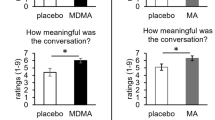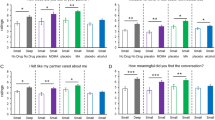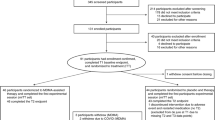Abstract
Abused drugs can profoundly alter mental states in ways that may motivate drug use. These effects are usually assessed with self-report, an approach that is vulnerable to biases. Analyzing speech during intoxication may present a more direct, objective measure, offering a unique ‘window’ into the mind. Here, we employed computational analyses of speech semantic and topological structure after ±3,4-methylenedioxymethamphetamine (MDMA; ‘ecstasy’) and methamphetamine in 13 ecstasy users. In 4 sessions, participants completed a 10-min speech task after MDMA (0.75 and 1.5 mg/kg), methamphetamine (20 mg), or placebo. Latent Semantic Analyses identified the semantic proximity between speech content and concepts relevant to drug effects. Graph-based analyses identified topological speech characteristics. Group-level drug effects on semantic distances and topology were assessed. Machine-learning analyses (with leave-one-out cross-validation) assessed whether speech characteristics could predict drug condition in the individual subject. Speech after MDMA (1.5 mg/kg) had greater semantic proximity than placebo to the concepts friend, support, intimacy, and rapport. Speech on MDMA (0.75 mg/kg) had greater proximity to empathy than placebo. Conversely, speech on methamphetamine was further from compassion than placebo. Classifiers discriminated between MDMA (1.5 mg/kg) and placebo with 88% accuracy, and MDMA (1.5 mg/kg) and methamphetamine with 84% accuracy. For the two MDMA doses, the classifier performed at chance. These data suggest that automated semantic speech analyses can capture subtle alterations in mental state, accurately discriminating between drugs. The findings also illustrate the potential for automated speech-based approaches to characterize clinically relevant alterations to mental state, including those occurring in psychiatric illness.
Similar content being viewed by others
Log in or create a free account to read this content
Gain free access to this article, as well as selected content from this journal and more on nature.com
or
References
Adler CM, Goldberg T, Malhotra AK, Pickar D, Breier A (1998). Effects of ketamine on thought disorder, working memory, and semantic memory in healthy volunteers. Biol Psychiatry 43: 811–816.
Adler CM, Malhotra AK, Elman I, Goldberg T, Egan M, Pickar D et al (1999). Comparison of ketamine-induced thought disorder in healthy volunteers and thought disorder in schizophrenia. Am J Psychiatry 156: 1646–1649.
Bedi G, Hyman D, de Wit H (2010). Is ecstasy an ‘empathogen’: effects of MDMA on prosocial feelings and identification of emotional states in others. Biol Psychiatry 68: 1134–1140.
Bedi G, Phan KL, Angstadt M, de Wit H (2009). Effects of MDMA on sociability and neural response to social threat and social reward. Psychopharmacology 207: 73–83.
Bird S, Klein E, Loper E (2009) Natural Language Processing with Python. O'Reilly Media: Sebastopol, CA.
Cami J, Farre M, Mas M, Roset PN, Poudevida S, Mas A et al (2000). Human pharmacology of 3,4-methylenedioxymethamphetamine (“Ecstasy”): psychomotor performance and subjective effects. J Clin Psychopharmacol 20: 455–466.
Carter LP, Griffiths RR (2009). Principles of laboratory assessment of drug abuse liability and implications for clinical development. Drug Alcohol Depend 105: S14–S25.
Cohen AS, Yunjung K, Najolia GM (2013). Psychiatric symptom versus neurocognitive correlates of diminished expressivity in schizophrenia and mood disorders. Schiz Res 146: 249–253.
Cohen AS, Najolia GM, Yunjung K, Dinzeo TJ (2012). On the boundaries of blunt affect/alogia across severe mental illness: implications for Research Domain Criteria. Schiz Res 140: 41–45.
Covington MA, Riedel WJ, Bron C, He C, Morris E, Weinsten S et al (2007). Does ketamine mimic aspects of schizophrenic speech? J Psychopharmacol 21: 338–346.
Coyle J, Presti D, Baggott M (2012). Quantitative analysis of narrative reports of psychedelic drugs. arXiv 1206.0312 [q-bioQM].
Deerwester SC, Dumais ST, Landauer TK, Furnas GW, Harshman RA (1990). Indexing by latent semantic analysis. JASIS 41: 391–407.
Diuk C, Fernandez Slezak D, Raskovsky I, Sigman M, Cecchi GA (2012). A quantitative philology of introspection. Front Integr Neurosci 6: 80.
Dumont GJ, Sweep FC, van der Steen R, Hermsen R, Donders AR, Touw DJ et al (2009). Increased oxytocin concentrations and prosocial feelings in humans after ecstasy (3,4-methylenedioxymethamphetamine) administration. Soc Neurosci 4: 359–366.
Dumont GJH, Verkes RJ (2006). A review of acute effects of 3,4-methylenedioxymethamphetmine in healthy volunteers. J Psychopharmacol 20: 176–187.
Elvevåg B, Foltz PW, Weinberger DR, Goldberg TE (2007). Quantifying incoherence in speech: an automated methodology and novel application to schizophrenia. Schiz Res 93: 304–316.
Fellbaum C (2010). WordNet. In Poli R, Healy M, Kameas A, (eds) Theory and Applications of Ontology: Computer Applications. Springer: Berlin, Germany.
Ferrer i Cancho R, Solé RV (2001). The small world of human language. Proc R Soc Lond B Biol Sci 268: 2261–2265.
Fischman MW, Foltin RW (2006). Utility of subjective-effects measurements in assessing abuse liability of drugs in humans. Br J Addict 86: 1563–1570.
Foltin R, Fischman M (1988). Effects of smoked marijuana on human social behavior in small groups. Pharmacol Biochem Behav 30: 539–541.
Haney M, Ward A, Comer S, Foltin R, Fischman M (1999). Abstinence symptoms following oral THC administration to humans. Psychopharmacology 141: 385–394.
Higgins ST, Stitzer ML (1986). Acute marijuana effects on social conversation. Psychopharmacology 89: 234–238.
Higgins ST, Stitzer ML (1988). Effects of alcohol on speaking in isolated humans. Psychopharmacology 95: 189–194.
Hughes B, Winstock AR (2012). Controlling new drugs under marketing regulations. Addiction 107: 1894–1899.
Huxley A (1970) The Doors of Perception. Perennial Library.
Hysek CM, Schmid Y, Simmler LD, Domes G, Heinrichs M, Eisenegger C et al (2013). MDMA enhances emotional empathy and prosocial behavior. Soc Cogn Affect Neurosci (in press).
Hysek CM, Simmler LD, Ineichen M, Grouzmann E, Hoener MC, Brenneisen R et al (2011). The norepinephrine transporter inhibitor reboxetine reduces stimulant effects of MDMA (“ecstasy”) in humans. Clin Pharmacol Ther 90: 246–255.
Landauer TK, Dumais ST (1998). A solution to Plato’s problem: the latent semantic analysis theory of acquisition, induction, and representation of knowledge. Psychol Rev 104: 211.
Liechti ME, Vollenweider FX (2001). Which neuroreceptors mediate the subjective effects of MDMA in humans? A summary of mechanistic studies. Hum Psychopharmacol 16: 590–598.
Low LS, Maddage NC, Lech M, Sheeber LB, Allen NB (2011). Detection of clinical depression in adolescents’ speech during family interactions. IEEE Trans Biomed Eng 58: 574–586.
Lund K, Burgess C (1996). Producing high-dimensional semantic spaces from lexical co-occurrence. Behav Res Methods Instrum Comput 28: 203–208.
Marrone GF, Pardo J, Krauss R, Hart C (2010). Amphetamine analogs methamphetamine and 3,4-methylenedioxymethamphetamine (MDMA) differentially affect speech. Psychopharmacology 208: 169–177.
Miller GA, Charles WG (1991). Contextual correlates of semantic similarity. Lang Cogn Proc 6: 1–28.
Mitchell SH, Laurent CL, de Wit H (1996). Interaction of expectancy and the pharmacological effects of d-amphetamine: subjective effects and self-administration. Psychopharmacology 125: 371–378.
Mithoefer MC, Wagner MT, Mithoefer AT, Jerome L, Doblin R (2011). The safety and efficacy of {+/-}3,4-methylenedioxymethamphetamine-assisted psychotherapy in subjects with chronic, treatment-resistant posttraumatic stress disorder: the first randomized controlled pilot study. J Psychopharmacol 25: 439–452.
Mota NB, Furtado R, Maia PPC, Capelli M, Ribeiro S (2014). Graph analysis of dream reports is especially informative about psychosis. Sci Rep 4: 3691.
Mota NB, Vasconcelos NA, Lemos N, Pieretti AC, Kinouchi O, Cecchi GA et al (2012). Speech graphs provide a quantitative measure of thought disorder in psychosis. PLoS One 7: e34928.
Ooi KE, Lech M, Allen NB (2013). Multichannel weighted speech classification system for prediction of major depression in adolescents. IEEE Trans Biomed Eng 60: 497–506.
Patwardhan S, Banerjee S, Pedersen T (2003). Using measures of semantic relatedness for word sense disambiguation. Proceedings of the Fourth International Conference on Intelligent Text Processing and Computational Linguistics 2003. Springer: Mexico City, Mexico.
Pedersen T, Patwardhan S, Michelizzi J (2004). WordNet: Similarity: measuring the relatedness of concepts. Proceedings of the Nineteenth National Conference on Artificial Intelligence 2004. Association for Computational Linguistics: San Jose, CA.
Quine WVO (1951). Two dogmas of empiricism. Philos Rev 60: 20–43.
Ramos L, Hicks C, Kevin R, Caminer A, Narlawar R, Kassiou M et al (2013). Acute prosocial effects of oxytocin and vasopressin when given alone or in combination with 3,4-methylenedioxymethamphetamine in rats: involvement of the V1A receptor. Neuropsychopharmacology 38: 2249–2259.
Rice P, Ezzy D (1999) Qualitative Research Methods, A Health Focus. Oxford University Press: Melbourne, Australia.
Sigman M, Cecchi GA (2002). Global organization of the Wordnet lexicon. Proc Natl Acad Sci USA 99: 1742–1747.
Stitzer ML, McCaul ME, Bigelow GE, Liebson IA (1984). Hydromorphone effects on human conversational speech. Psychopharmacology 84: 402–404.
Sumnall HR, Cole JC, Jerome L (2006). The varieties of ecstasy experience: an exploration of the subjective experiences of ecstasy. J Psychopharmacol 20: 670–682.
Tagamets MA, Cortes CR, Greigo JA, Elvevåg B (2013). Neural correlates of the relationship between discourse coherence and sensory monitoring in schizophrenia. Cortex (in press).
Thompson MR, Callaghan PD, Hunt GE, Cornish JL, McGregor IS (2007). A role for oxytocin and 5-HT(1A) receptors in the prosocial effects of 3,4-methylenedioxymethamphetamine (“ecstasy”). Neuroscience 146: 509–514.
Wardle MC, Garner MJ, Munafo MR, de Wit H (2012). Amphetamine as a social drug: effects of d-amphetamine on social processing and behavior. Psychopharmacology 223: 199–210.
Acknowledgements
We thank participants for their involvement and Lisa Jerome for comments on an earlier draft. This research was supported by the National Institute on Drug Abuse (DA029679, DA034877, DA026570, and DA02812).
Author information
Authors and Affiliations
Corresponding author
Additional information
Supplementary Information accompanies the paper on the Neuropsychopharmacology website
PowerPoint slides
Rights and permissions
About this article
Cite this article
Bedi, G., Cecchi, G., Slezak, D. et al. A Window into the Intoxicated Mind? Speech as an Index of Psychoactive Drug Effects. Neuropsychopharmacol 39, 2340–2348 (2014). https://doi.org/10.1038/npp.2014.80
Received:
Revised:
Accepted:
Published:
Issue date:
DOI: https://doi.org/10.1038/npp.2014.80
This article is cited by
-
Analysis of recreational psychedelic substance use experiences classified by substance
Psychopharmacology (2022)
-
Detection of acute 3,4-methylenedioxymethamphetamine (MDMA) effects across protocols using automated natural language processing
Neuropsychopharmacology (2020)
-
Long-term follow-up outcomes of MDMA-assisted psychotherapy for treatment of PTSD: a longitudinal pooled analysis of six phase 2 trials
Psychopharmacology (2020)
-
Computational Approaches to Behavior Analysis in Psychiatry
Neuropsychopharmacology (2018)
-
Considering the context: social factors in responses to drugs in humans
Psychopharmacology (2018)



